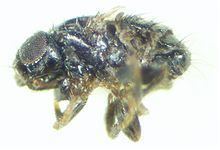Higher classification Carnus Order Fly | Section Schizophora Genus Carnus Rank Species | |
 | ||
Similar Fly, Carnidae, Milichiidae, Protocalliphora, Syringogaster | ||
Carnus hemapterus is a Dipteran insect, a small-bodied and mostly black-coloured carnid fly. In general, larvae of most carnid flies are detritivores, while the imagines are often seen feeding on carcasses, faeces, or umbelliferous flowers.
However, imagines of the genus Carnus are blood-sucking ectoparasites of nestling birds. Within this genus, Carnus hemapterus is the only species widespread across Europe and the northern and temperate regions of Asia and America. Female body length is about 1.5 mm, males are smaller. It typically occurs in the nests of medium- to large-bodied birds, provided that the nest is not on the ground. It is particularly common on the chicks of owls, falcons, rollers, bee-eaters and starlings. Females give birth to larvae that live within the nest and feed on organic debris and the pupae also overwinter there. The emergence of imagines is synchronized to the hatch of host nestlings in the subsequent year. They prefer larger chicks within the nest. Adult flies have a winged and an unwinged variety, the latter being much commoner. In fact, unwinged flies still carry the basal part of their wings, but the majority of the wing is broken off (see a close view of the above photo). Flies live only on the nestlings before and during the development of the plumage, and disappear later on.
Infestations by Carnus hemapterus appear to be rather harmless for the host chicks. In spite of that, barn owl females advertise their resistance genes by the dark spots on their breast and belly; nestlings of heavily spotted females tend to be more resistant. In this study, potential environmental confounding effects were controlled for by cross-fostering chicks. The spots on the eggs of spotless starlings also predict nestling resistance against Carnus infestations, although the adaptive value of this phenomenon is not clear.
